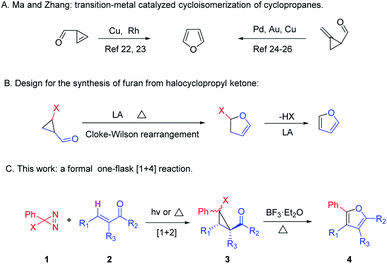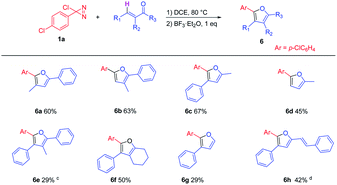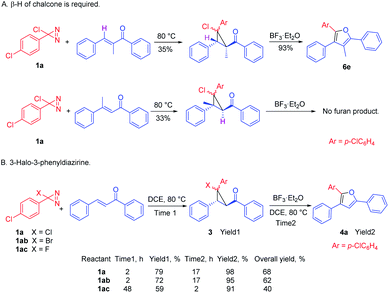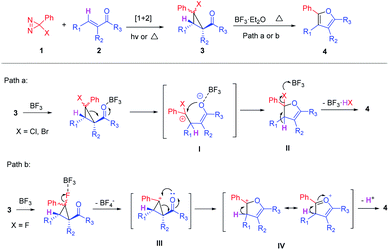 Open Access Article
Open Access ArticleA facile metal-free one-flask synthesis of multi-substituted furans via a BF3·Et2O mediated formal [4 + 1] reaction of 3-chloro-3-phenyldiazirines and α,β-alkenyl ketones†
Zixin Zhanga,
Aimin Huanga,
Lin Maa,
Jian-hua Xub and
Min Zhang *a
*a
aSchool of Chemistry and Chemical Engineering, Guangxi University, Nanning, Guangxi 530004, China. E-mail: chemizhang@gxu.edu.cn
bSchool of Chemistry and Chemical Engineering, Nanjing University, Nanjing, Jiangsu 210093, China
First published on 18th May 2022
Abstract
A facile, efficient and metal free one-flask approach to diversely substituted furans from easily accessible 3-chloro-3-phenyldiazirines and α,β-alkenyl ketones is reported. This protocol integrates three steps of cyclopropanation, Cloke–Wilson rearrangement and elimination of HCl in one-flask to give products in moderate to good yields. It provides a metal and oxidant free approach to multi-substituted furans with the advantages of easy operation, mild reaction conditions and a broad scope of substrates.
Introduction
Furan is a five-membered oxygenated heteroaromatic which is widely spread in natural products1 and plays an important role in both pharmaceutical chemistry2,3 and in synthetic organic chemistry as a useful building block.2,4–6 Long attracting the interests of chemists, a number of synthetic methods for furan have been developed,3,7–12 including the cyclodehydration of dicarbonyl compounds through Paal–Knorr synthesis13 and Feist–Bénary cyclocondensation.14,15 Nevertheless, more selective approaches to multi-substituted furans under mild conditions still remain a challenging task.In the past decades, cyclopropane has been widely used as a three-carbon synthon to access variable chemicals due to the readiness of ring-opening from high angle and torsion strain and tunable reactivity by substituent-controlled C–C bond polarization/cleavage.16–21 Transition-metal catalyzed intramolecular ring-opening cycloisomerization of cyclopropenyl ketones22,23 or alkylidene cyclopropyl ketones24–26 has been proved to be a very successful and reliable approach to furans (Scheme 1A). Early in 2003, Ma and Zhang22 developed a regioselective cycloisomerization of cyclopropenyl ketones using copper(I) or Pd catalysts. Later in 2004, they developed a Pd mediated ring-opening cycloisomerization of 2-methylene- or alkylidene cyclopropyl ketone to di- or tri-substituted furans.24 In 2007, Liang group reported a synthesis of trisubstituted furans via a Cu(I)-catalyzed formal [4 + 1] cycloaddition of α,β-alkynyl ketones with diazoacetates.27 Xu and co-workers further developed a Cu–Pd relay catalysis to access tetra-substituted furans from cyclopropenes.28 These elegant transition-metal catalyzed methods are advantageous in both atom economy and efficiency. However, using alternative non-metal catalysts to promote cycloisomerization is very essential in account of economic, environmental and sustainability requirement. Recently, Wang and coworkers29–31 have developed I2/K2CO3 or DBU mediated ring opening and cyclization of cyano-substituted cyclopropyl ketones to afford furan derivatives.
The Cloke–Wilson rearrangement (CWR) reaction has been intensively used to access dihydrofurans from cyclopropyl ketones.32–37 Besides transition-metal catalysis,38,39 CWR reaction can also be promoted by Lewis acid,40,41 photocatalysis,42–44 and organo-catalysis.26,32,33 Regrettably, an extra dehydrogenation procedure is a prerequisite to transform dihydrofurans to furans using stoichiometric oxidants such as DDQ.45,46 To avoid the harmful oxidation procedure, we envisioned that halocyclopropyl ketone is an ideal alternative precursor to perform CWR reaction to deliver halogenated dihydrofuran, which is converted to furan via elimination of HX (Scheme 1B). However, there are few reports making use of this elimination strategy. As an elegant example, Namboothiri's group reported that acidic Al2O3 could be used to promote CWR reaction of dibromocyclopropyl ketone followed by elimination to access 3-bromo furans.47,48
Taking advantage of the fact that the highly reactive halocarbenes (RCX) derived from the easily available 3-halodiazirines (RCN2X) upon the loss of N2 readily take part in [2 + 1] cycloaddition with alkenes to give halogenated cyclopropanes,49–52 we design a formal [4 + 1] approach to furans using this cyclopropanation method to obtain the required halocyclopropyl ketone precursors (Scheme 1C). Firstly, photolysis or thermolysis of 3-halo-3-phenyldiazirine 1 in the presence of α,β-alkenyl ketone 2 gives the halocyclopropyl ketone 3, which is then subjected to a tandem CWR–elimination reaction sequence to afford the furan 4. We further succeeded in using the same Lewis acid to promote both the CWR and the elimination reactions to facilitate the reaction procedure. As a result, we herein report a one-flask metal-free synthetic approach to a diversity of di-, tri- or tetra-substituted furans from a series of 3-halo-3-phenyldiazirines and α,β-alkenyl ketones via cylopropanation and BF3·Et2O mediated CWR–elimination reactions.
Results and discussions
Initially, the synthesis of halocyclopropyl ketones was investigated (Scheme 2). Photolysis or thermolysis of 3-chloro-3-(4-chlorophenyl)diazirine (1a) was used to generate phenylchlorocarbene (PhCCl) in situ, which rapidly reacted with chalcone (2a) to give the halocyclopropyl ketone diastereomers (3a/3a′). After an optimization of solvents and temperatures (for details, please see Table S1†), either photolysis at room temperature or thermolysis at 80 °C in 1,2-dichloroethane (DCE) gave the halocyclopropyl ketones (3a/3a′) in highest yield with similar diastereoselectivity.Next, the transformation of halocyclopropyl ketone 3a (major isomer) to furan 4a was investigated and selected results are summarized in Table 1 (for more details, see Table S2†). Lewis acid promoters FeCl3·6H2O, TiCl4 and FeCl2·4H2O were the most efficient catalysts for this conversion (0.08–0.5 h), while BF3·Et2O, AlCl3, SnCl4 and Sc(OTf)3 promoted the reaction less efficiently (15–45 h). Delightfully, furan 4a was obtained in excellent yields (85–98%) in the presence of these seven catalysts (entries 1–7). On the contrary, BiCl3 couldn't complete this transformation in 72 h and gave 4a in lower yield (entry 8). No reaction could take place in the absence of a Lewis acid (entry 9). Brønsted acid para-toluene sulfonic acid (PTSA) could also mediate this reaction to give 4a in 90% yield in 36 h (entry 10). Therefore, among these promoters, BF3·Et2O and FeCl2·4H2O showed the best catalytic activity to give nearly quantitative yields of 4a. It is also noted that the halocyclopropyl ketone diastereomer 3a′ was similarly converted to 4a in the nearly quantitative yield as 3a in the presence of either BF3·Et2O or FeCl2·4H2O (entries 12–13). Therefore, there is no need to separate two diastereomers 3a/3a′ for the transformation to 4a. We then succeeded in implementing these reaction steps in one-flask (for details, please see Table S3†) with BF3·Et2O (1 eq.) as the best catalyst, which was added into the flask after the completion of cyclopropanation to avoid side reactions. This one-flask protocol gave 4a in an overall yield of 68%.
| Entry | Lewis acid | Time, h | Yield,b % |
|---|---|---|---|
| a Reagents and conditions: halocyclopropyl ketone 3a (0.06 mmol), Lewis acid (0.06 mmol, 1 eq.) in 5 mL DCE was heated at 80 °C in a 38 mL reaction tube equipped with a condenser until the reaction was completed by TLC monitoring. NR = no reaction. RSM = recovery of starting material.b Isolated yield.c Yield is based on consumed halocyclopropyl ketone. RSM was 16%.d 0.2 eq. LA was used.e 3a′ was used instead of 3a. | |||
| 1 | TiCl4 | 0.16 | 86 |
| 2 | FeCl2·4H2O | 0.5 | 96 |
| 3 | FeCl3·6H2O | 0.08 | 86 |
| 4 | BF3·Et2O | 15 | 98 |
| 5 | AlCl3 | 17 | 90 |
| 6 | SnCl4 | 21 | 87 |
| 7 | Sc(OTf)3 | 45 | 86 |
| 8 | BiCl3 | 72 | 68c |
| 9 | None | 24 | NR |
| 10 | PTSA | 36 | 90 |
| 11d | FeCl2·4H2O | 1 | 97 |
| 12e | BF3·Et2O | 16 | 98 |
| 13d,e | FeCl2·4H2O | 1 | 97 |
With this optimized one-flask conditions in hand, we investigated the scope of para-substituted phenylchlorodiazirines 1 (Table 2). Unsubstituted (R = H) or substituted phenylchlorodiazirines with either electron-donating (R = Me, OMe) or slightly electron withdrawing (R = F, Cl) groups on the phenyl ring gave furans (4a–4e) in good yields (57–71%). However, the cyclopropyl ketones with strong electron-withdrawing substituents such as CF3 or CN (3f, 3g) need to be heated in n-octane at 120 °C to give furans in reasonable yields (4f 43%; 4g 42%) due to lower ring opening reactivity for less polarization character of C–C bond. This conversion could also be driven by the powerful FeCl3·6H2O and gave furans in better yields (4f 57%; 4g 53%). However, the reaction of 3-benzyl-3-chloro-diazirine (PhCH2CClN2) and chalcone couldn't afford the expected furan. The scope of chalcones were also investigated: chalcones with substituents on either phenyl ring gave furans (5a–5i; 5m–5t) in good yields (70–80%), no matter they are electron-withdrawing or electron-donating. This one-flask strategy can also be applied to the naphthyl, thiophenyl or pyridinyl substituted chalcones to afford furans (5j–5l, 5u) with moderate to good yields (40–78%).
| a Reagents and conditions (method A): 3-aryl-3-chlorodiazirine 1 (0.2 mmol), alkenyl ketone 2 (0.2 mmol) in 5 mL DCE was heated at 80 °C in a 38 mL reaction tube with a condenser until the reaction was completed (usually 2 h). BF3·Et2O (0.2 mmol, 1 eq.) was added in and kept on heating to complete the transformation.b Isolated yield of one-flask reaction.c Reacted at 120 °C in n-octane and BF3·Et2O (5 eq.) was used. |
|---|
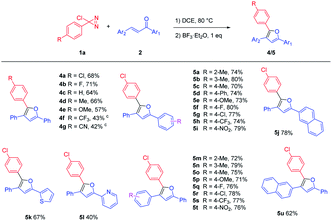 |
We further extended this one-flask reaction to a wide range of alkenyl ketones with alkyl groups, and the corresponding furans were obtained in moderate to good yields (Table 3). Alkenyl ketones substituted with a methyl group at R1, R2 or R3 position gave trisubstituted furans 6a–6c in good yields (60–67%). Methyl vinyl ketone (MVK) gave 2-methyl-5-phenyl furan 6d in 45% yield. Notably, this protocol enabled an astonishing access to tetra-substituted furans with structural complexity (6e, 6f). For example, 2-benzylidenecyclohexan-1-one gave tetra-substituted furan 6f with a fused ring in good yield (50%). This protocol can also be applied to α,β-unsaturated aldehydes, e.g., cinnamaldehyde was used to synthesize 2,3-disubstituted furan 6g in 29% yield. Bis(2-phenylvinyl) ketone gave furan 6h in 42% yield, exemplifying the functional group tolerance for another sensitive C![[double bond, length as m-dash]](https://www.rsc.org/images/entities/char_e001.gif) C double bond. Step-by-step analysis of these two-stage reactions (Table S5†) reveals that the lower yields were owing to the poor cyclopropanation reactivity because of less electronic richness (6d, 6g) or steric hindrance (6e) of the C
C double bond. Step-by-step analysis of these two-stage reactions (Table S5†) reveals that the lower yields were owing to the poor cyclopropanation reactivity because of less electronic richness (6d, 6g) or steric hindrance (6e) of the C![[double bond, length as m-dash]](https://www.rsc.org/images/entities/char_e001.gif) C double bond, in which a considerable amount of carbene dimer was often generated as side product. Therefore, this one-flask protocol can use a variety of α,β-unsaturated carbonyl substrates to synthesize 2,3- or 2,5-disubstituted, 2,3,5-trisubstituted and even 2,3,4,5-tetrasubstituted furans with moderate to good yields.
C double bond, in which a considerable amount of carbene dimer was often generated as side product. Therefore, this one-flask protocol can use a variety of α,β-unsaturated carbonyl substrates to synthesize 2,3- or 2,5-disubstituted, 2,3,5-trisubstituted and even 2,3,4,5-tetrasubstituted furans with moderate to good yields.
To probe the mechanism of these reactions, β-methyl chalcone was subjected to this one-flask reaction (Scheme 3A). Unlike the α-methyl chalcone, the CWR–elimination reaction of the cyclopropyl ketone promoted by BF3 gave a complicated mixture without any furan product, indicating the necessity of a β-hydrogen. Reactivities of other 3-halo-3-phenyldiazirines (X = Br, F) were also studied (Scheme 3B). 3-Bromo-3-phenyldiazirine (1ab) gave bromocyclopropyl ketone 3ab/3ab′ in 2 h (72%), which gave furan 4a in 95% yield in 17 h with the similar reactivity as 3a/3a′ (X = Cl). It indicates that BF3 is supposed to bind with the oxygen in carbonyl group instead of halogen to promote the CWR reaction, leading to no significant difference in the reactivities between 3a and 3ab (Scheme 4, path a). On the other hand, 3-fluoro-3-phenyldiazirine (1ac) gave the cyclopropyl ketone 3ac (59%) much slower (48 h) owing to the less electrophilicity and stability of phenylfluorocarbene (PhCF).53,54 Moreover, 3ac is quite ready to give furan 4a in 90% yield with excellent reactivity (2 h). This efficient transformation is supposed to be attributed to a different pathway because of the high affinity between BF3 and fluorine (vide infra).
Based on these experiments and literature,34,47,55 a plausible mechanism is proposed in Scheme 4. Upon thermolysis or photolysis, 3-halo-3-phenyldiazirine (1) generates electrophilic singlet phenylhalocarbene (PhCX) with the loss of nitrogen (N2).51,56 The PhCX carbene reacts rapidly with α,β-alkenyl ketone (2) to afford halocyclopropyl ketone (3) via a [2 + 1] cycloaddition. Subsequent addition of BF3·Et2O catalyzes the CWR rearrangement of chloro- or bromocyclopropyl ketone 3a/3ab by complexing with the carbonyl oxygen in 3 (path a) to facilitate the heterolytic cleavage of this donor–acceptor cyclopropane to give the key zwitterion intermediate I. Then, an intramolecular cyclization of I by nucleophilic attack of oxyanion to carbocation gives dihydrofuran II, which is converted to furan 4 after the loss of HX with the aid of BF3. In the case of fluorocyclopropyl ketone 3ac, the ring-opening might be driven by the loss of tetrafluoroborate (BF4−) and proceeds through a cyclopropyl carbocation mechanism in a similar intramolecular cyclization mode (path b).
Conclusions
In conclusion, we have developed a facile one-flask approach to the di-, tri- and even tetra-substituted furans in moderate to good yields from readily available starting materials using inexpensive boron trifluoride as catalyst. This metal and oxidant free method involves the cyclopropanation of α,β-alkenyl ketones with phenylchlorocarbene, BF3 mediated ring-opening cycloisomerization (Cloke–Wilson rearrangement) and elimination of HCl to give the multi-substituted furans. This method has the advantages of simple operation, mild reaction conditions and a broad scope of substrates, which provides a concise approach to diversified biologically and synthetically useful furans. We believe it will benefit the discovery of new application of furan derivatives.Author contributions
Z. Zhang: most of the experimental work and writing of ESI.† A. Huang & L. Ma: methodology and discussion. J. Xu: manuscript revision and discussion. M. Zhang: conceptualization, funding acquisition, supervision, and writing, review, and editing of the manuscript.Conflicts of interest
The authors declare no competing financial interest.Acknowledgements
We thank the National Natural Science Foundation of China (No. 21861002, 21462003) for financial support.Notes and references
- Z. Batool, D. Xu, X. Zhang, X. Li, Y. Li, Z. Chen, B. Li and L. Li, A review on furan: formation, analysis, occurrence, carcinogenicity, genotoxicity and reduction methods, Crit. Rev. Food Sci., 2021, 61, 395–406 CrossRef CAS PubMed.
- H.-K. Lee, K.-F. Chan, C.-W. Hui, H.-K. Yim, X.-W. Wu and H. N. C. Wong, Use of furans in synthesis of bioactive compounds, Pure Appl. Chem., 2005, 77, 139–143 CrossRef CAS.
- A. Blanc, V. Bénéteau, J.-M. Weibel and P. Pale, Silver & gold-catalyzed routes to furans and benzofurans, Org. Biomol. Chem., 2016, 14, 9184–9205 RSC.
- B. H. Lipshutz, Five-membered heteroaromatic rings as intermediates in organic synthesis, Chem. Rev., 1986, 86, 795–819 CrossRef CAS.
- H. N. C. Wong, P. Yu and C. Y. Yick, The use of furans in natural product syntheses, Pure Appl. Chem., 1999, 71, 1041–1044 CrossRef CAS.
- A. S. Makarov, M. G. Uchuskin and I. V. Trushkov, Furan Oxidation Reactions in the Total Synthesis of Natural Products, Synthesis, 2018, 50, 3059–3086 CrossRef CAS.
- X. L. Hou, H. Y. Cheung, T. Y. Hon, P. L. Kwan, T. H. Lo, S. Y. Tong and H. N. C. Wong, Regioselective syntheses of substituted furans, Tetrahedron, 1998, 54, 1955–2020 CrossRef CAS.
- R. C. D. Brown, Developments in Furan Syntheses, Angew. Chem., Int. Ed., 2005, 44, 850–852 CrossRef CAS PubMed.
- S. F. Kirsch, Syntheses of polysubstituted furans: recent developments, Org. Biomol. Chem., 2006, 4, 2076–2080 RSC.
- N. T. Patil and Y. Yamamoto, Coinage Metal-Assisted Synthesis of Heterocycles, Chem. Rev., 2008, 108, 3395–3442 CrossRef CAS PubMed.
- A. Deepthi, B. P. Babu and A. L. Balachandran, Synthesis of Furans - Recent Advances, Org. Prep. Proced. Int., 2019, 51, 409–442 CrossRef CAS.
- D. X. Duc, Recent Progress in the Synthesis of Furan, Mini-Rev. Org. Chem., 2019, 16, 422–452 CrossRef CAS.
- G. Minetto, L. F. Raveglia, A. Sega and M. Taddei, Microwave-Assisted Paal–Knorr Reaction – Three-Step Regiocontrolled Synthesis of Polysubstituted Furans, Pyrroles and Thiophenes, Eur. J. Org. Chem., 2005, 5277–5288 CrossRef CAS.
- M. A. Calter, C. Zhu and R. J. Lachicotte, Rapid Synthesis of the 7-Deoxy Zaragozic Acid Core, Org. Lett., 2002, 4, 209–212 CrossRef CAS PubMed.
- G. Mross, E. Holtz and P. Langer, Synthesis of 2-Alkenyl-3-(alkoxycarbonyl)furans Based on Feist–Benary Cyclocondensation of (2,4-Dioxobutylidene)phosphoranes with α-Haloketones and α-Chloracetaldehyde, J. Org. Chem., 2006, 71, 8045–8049 CrossRef CAS PubMed.
- H.-U. Reissig and R. Zimmer, Donor–Acceptor-Substituted Cyclopropane Derivatives and Their Application in Organic Synthesis, Chem. Rev., 2003, 103, 1151–1196 CrossRef CAS PubMed.
- M. A. Cavitt, L. H. Phun and S. France, Intramolecular donor–acceptor cyclopropane ring-opening cyclizations, Chem. Soc. Rev., 2014, 43, 804–818 RSC.
- T. F. Schneider, J. Kaschel and D. B. Werz, A New Golden Age for Donor–Acceptor Cyclopropanes, Angew. Chem., Int. Ed., 2014, 53, 5504–5523 CrossRef CAS.
- K. R. Babu, X. He and S. Xu, Lewis Base Catalysis Based on Homoconjugate Addition: Rearrangement of Electron-Deficient Cyclopropanes and Their Derivatives, Synlett, 2020, 31, 117–124 CrossRef CAS.
- Y. Xia, X. Liu and X. Feng, Asymmetric Catalytic Reactions of Donor–Acceptor Cyclopropanes, Angew. Chem., Int. Ed., 2021, 60, 9192–9204 CrossRef CAS PubMed.
- T. R. McDonald, L. R. Mills, M. S. West and S. A. L. Rousseaux, Selective Carbon–Carbon Bond Cleavage of Cyclopropanols, Chem. Rev., 2021, 121, 3–79 CrossRef CAS PubMed.
- S. Ma and J. Zhang, 2,3,4- or 2,3,5-Trisubstituted furans: catalyst-controlled highly regioselective ring-opening cycloisomerization reaction of cyclopropenyl ketones, J. Am. Chem. Soc., 2003, 125, 12386–12387 CrossRef CAS PubMed.
- A. Padwa, J. M. Kassir and S. L. Xu, Rhodium-catalyzed ring-opening reaction of cyclopropenes. Control of regioselectivity by the oxidation state of the metal, J. Org. Chem., 2002, 56, 6971–6972 CrossRef.
- S. Ma and J. Zhang, Tuning the Regioselectivity in the Palladium(II)-Catalyzed Isomerization of Alkylidene Cyclopropyl Ketones: A Dramatic Salt Effect, Angew. Chem., Int. Ed., 2003, 42, 183–187 CrossRef CAS PubMed.
- S. Ma, L. Lu and J. Zhang, Catalytic Regioselectivity Control in Ring-Opening Cycloisomerization of Methylene- or Alkylidenecyclopropyl Ketones, J. Am. Chem. Soc., 2004, 126, 9645–9660 CrossRef CAS PubMed.
- X. He, Y. Tang, Y. Wang, J. B. Chen, S. Xu, J. Dou and Y. Li, Phosphine-Catalyzed Activation of Alkylidenecyclopropanes: Rearrangement to Form Polysubstituted Furans and Dienones, Angew. Chem., Int. Ed., 2019, 58, 10698–10702 CrossRef CAS PubMed.
- L.-B. Zhao, Z.-H. Guan, Y. Han, Y.-X. Xie, S. He and Y.-M. Liang, Copper-Catalyzed [4 + 1] Cycloadditions of α,β-Acetylenic Ketones with Diazoacetates to Form Trisubstituted Furans, J. Org. Chem., 2007, 72, 10276–10278 CrossRef CAS PubMed.
- C. Song, J. Wang and Z. Xu, Tandem metal relay catalysis: from cyclopropene to polysubstituted furan, Org. Biomol. Chem., 2014, 12, 5802–5806 RSC.
- W. Ye, C. Tan, J. Yao, S. Xue, Y. Li and C. Wang, Iodine-Promoted Domino Reactions of 1-Cyanocyclopropane 1-Esters: A Straightforward Approach to Fully Substituted 2-Aminofurans, Adv. Synth. Catal., 2016, 358, 426–434 CrossRef CAS.
- J.-M. Liu, X.-Y. Liu, X.-S. Qing, T. Wang and C.-D. Wang, I2/K2CO3-Promoted ring-opening/cyclization/rearrangement/aromatization sequence: a powerful strategy for the synthesis of polysubstituted furans, Chin. Chem. Lett., 2017, 28, 458–462 CrossRef CAS.
- Z. Su, Z. Xie, S. Wang, N. Luo and C. Wang, Direct synthesis of highly functionalized furans from donor-acceptor cyclopropanes via DBU-mediated ring expansion reactions, Org. Biomol. Chem., 2019, 17, 7342–7351 RSC.
- J. Zhang, Y. Tang, W. Wei, Y. Wu, Y. Li, J. Zhang, Y. Zheng and S. Xu, Organocatalytic Cloke-Wilson Rearrangement: DABCO-Catalyzed Ring Expansion of Cyclopropyl Ketones to 2,3-Dihydrofurans, Org. Lett., 2017, 19, 3043–3046 CrossRef CAS PubMed.
- W. Wei, Y. Tang, Y. Zhou, G. Deng, Z. Liu, J. Wu, Y. Li, J. Zhang and S. Xu, Recycling Catalyst as Reactant: A Sustainable Strategy to Improve Atom Efficiency of Organocatalytic Tandem Reactions, Org. Lett., 2018, 20, 6559–6563 CrossRef CAS.
- Q. Shi, Y. Wang and D. Wei, Theoretical study on DABCO-catalyzed ring expansion of cyclopropyl ketone: mechanism, chemoselectivity, and role of catalyst, Comput. Theor. Chem., 2018, 1123, 20–25 CrossRef CAS.
- A. Ortega, R. Manzano, U. Uria, L. Carrillo, E. Reyes, T. Tejero, P. Merino and J. L. Vicario, Catalytic Enantioselective Cloke–Wilson Rearrangement, Angew. Chem., Int. Ed., 2018, 57, 8225–8229 CrossRef CAS PubMed.
- H. Nambu, Y. Onuki, N. Ono and T. Yakura, Iodide-Catalyzed Ring-Opening Cyclization of Cyclohexane-1,3-dione-2-spirocyclopropanes, Adv. Synth. Catal., 2018, 360, 2938–2944 CrossRef CAS.
- X. Liang, P. Guo, W. Yang, M. Li, C. Jiang, W. Sun, T. P. Loh and Y. Jiang, Stereoselective synthesis of trifluoromethyl-substituted 2H-furan-amines from enaminones, Chem. Commun., 2020, 56, 2043–2046 RSC.
- R. K. Bowman and J. S. Johnson, Nickel-catalyzed rearrangement of 1-acyl-2-vinylcyclopropanes. A mild synthesis of substituted dihydrofurans, Org. Lett., 2006, 8, 573–576 CrossRef CAS PubMed.
- M. L. Piotrowski and M. A. Kerr, Tandem Cyclopropanation/Vinylogous Cloke–Wilson Rearrangement for the Synthesis of Heterocyclic Scaffolds, Org. Lett., 2018, 20, 7624–7627 CrossRef CAS PubMed.
- V. K. Yadav and R. Balamurugan, Silicon-assisted ring opening of donor-acceptor substituted cyclopropanes. An expedient entry to substituted dihydrofurans, Org. Lett., 2001, 3, 2717–2719 CrossRef CAS PubMed.
- Y. Y. Zhu, M. L. Zhang, T. Li and X. X. Song, AlCl3-Promoted Stereospecific Cloke-Wilson Rearrangement of Spirocyclopropyl Barbiturates for the Synthesis of Substituted Dihydrofuro[2,3-d]pyrimidines, ChemistrySelect, 2019, 4, 10838–10842 CrossRef CAS.
- D. Kalpogiannaki, C.-I. Martini, A. Nikopoulou, J. A. Nyxas, V. Pantazi and L. P. Hadjiarapoglou, Fused dihydrofurans from the one-pot, three-component reaction of 1,3-cyclohexanedione, iodobenzene diacetate and alkenes, Tetrahedron, 2013, 69, 1566–1575 CrossRef CAS.
- C.-H. Lin, D. Pursley, J. E. M. N. Klein, J. Teske, J. A. Allen, F. Rami, A. Köhn and B. Plietker, Non-decarbonylative photochemical versus thermal activation of Bu4N[Fe(CO)3(NO)] – the Fe-catalyzed Cloke–Wilson rearrangement of vinyl and arylcyclopropanes, Chem. Sci., 2015, 6, 7034–7043 RSC.
- J. Luis-Barrera, V. Laina-Martín, T. Rigotti, F. Peccati, X. Solans-Monfort, M. Sodupe, R. Mas-Ballesté, M. Liras and J. Alemán, Visible-Light Photocatalytic Intramolecular Cyclopropane Ring Expansion, Angew. Chem., Int. Ed., 2017, 56, 7826–7830 CrossRef CAS PubMed.
- N. M. Barl, E. Sansiaume-Dagousset, G. Monzón, A. J. Wagner and P. Knochel, Preparation and Reactions of Heteroarylmethylzinc Reagents, Org. Lett., 2014, 16, 2422–2425 CrossRef CAS PubMed.
- A. Lévesque, T. Maris and J. D. Wuest, ROY Reclaims Its Crown: New Ways to Increase Polymorphic Diversity, J. Am. Chem. Soc., 2020, 142, 11873–11883 CrossRef PubMed.
- N. Satam, S. Nemu, G. N. Gururaja and I. N. N. Namboothiri, Substrate-oriented selectivity in the Mg-mediated conjugate addition of bromoform to electron-deficient alkenes, Org. Biomol. Chem., 2020, 18, 5697–5707 RSC.
- E. Gopi and I. N. N. Namboothiri, Synthesis of Fused Bromofurans via Mg-Mediated Dibromocyclopropanation of Cycloalkanone-Derived Chalcones and Cloke–Wilson Rearrangement, J. Org. Chem., 2013, 78, 910–919 CrossRef CAS PubMed.
- R. A. Moss, Diazirines: Carbene Precursors Par Excellence, Acc. Chem. Res., 2006, 39, 267–272 CrossRef CAS PubMed.
- M. Zhang, R. A. Moss, J. Thompson and K. Krogh-Jespersen, Evolution of Structure and Reactivity in a Series of Iconic Carbenes, J. Org. Chem., 2012, 77, 843–850 CrossRef CAS PubMed.
- L. Wang, K. Krogh-Jespersen and R. A. Moss, Activation Parameters for Additions to Alkenes of Arylchlorocarbenes with Enhanced Electrophilicity, J. Org. Chem., 2015, 80, 7590–7593 CrossRef CAS PubMed.
- E. M. D. Allouche and A. B. Charette, Cyclopropanation Reactions of Semi-stabilized and Non-stabilized Diazo Compounds, Synthesis, 2019, 51, 3947–3963 CrossRef CAS.
- R. A. Moss, Carbenic selectivity in cyclopropanation reactions, Acc. Chem. Res., 1980, 13, 58–64 CrossRef CAS.
- I. R. Gould, N. J. Turbo, J. Butcher, C. Doubleday, N. P. Hacker, G. F. Lehr, R. A. Moss, D. P. Cox, W. Guo, R. C. Munjal, L. A. Perez and M. Fedorynski, Time-resolved flash spectroscopic investigations of the reactions of singlet arylhalocarbenes, Tetrahedron, 1985, 41, 1587–1600 CrossRef CAS.
- T. Li, D. Yan, C. Cui, X. Song and J. Chang, A thermal decarboxylative Cloke-Wilson rearrangement of dispirocyclopropanes derived from para-quinone methides and bromo-Meldrum's acids: an approach to synthesize spirobutyrolactone para-dienones, Org. Chem. Front., 2020, 7, 2682–2688 RSC.
- G. Richter, E. Mendez-Vega and W. Sander, Singlet Halophenylcarbenes as Strong Hydrogen-Bond Acceptors, J. Phys. Chem. A, 2016, 120, 3524–3532 CrossRef CAS PubMed.
Footnote |
| † Electronic supplementary information (ESI) available. See https://doi.org/10.1039/d2ra01472f |
| This journal is © The Royal Society of Chemistry 2022 |

